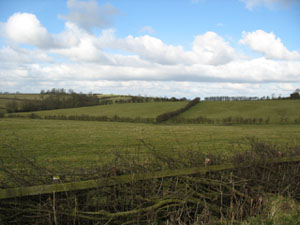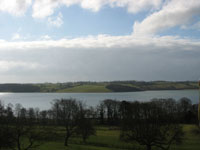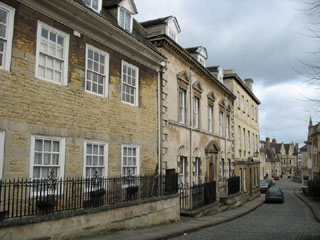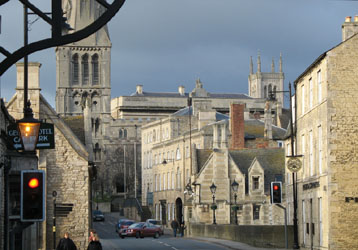Back on the Map
Rutland
by Sarah Shuckburgh
 When
I was at school, Rutland was famous for being England’s
smallest county. But soon after I gave up Geography, the
shire ceased to exist. Over the years, I’ve heard my mother
talking about bird-watching there, but until last weekend I
knew nothing else about Rutland. When
I was at school, Rutland was famous for being England’s
smallest county. But soon after I gave up Geography, the
shire ceased to exist. Over the years, I’ve heard my mother
talking about bird-watching there, but until last weekend I
knew nothing else about Rutland.
I was in for some delightful surprises. For a start, the
county exists again – after two decades as part of
Leicestershire, Rutland regained its independence in 1997.
Secondly, it is wonderfully unspoilt, with pretty villages
built of local ironstone, interesting 12th century churches,
and huge views of sky and undulating countryside - an
eastern Cotswolds, if you like.
Turning off the A1, I find myself driving along narrow lanes
bordered with ancient thorn hedges, past fields still marked
with medieval furrows, unploughed since the enclosures – a
fox-hunting landscape of pasture and woodland.
 A
reservoir created thirty years ago to supply water for the
East Midlands is now a beautiful, glittering lake, and one
of Britain’s finest nature reserves. The bird-watching
centre at Egleton protects a thousand acres of reed beds,
lagoons and islands, where 300 species of bird have been
recorded. My friend Jane and I arrange to meet here on
Saturday morning, and immediately I see why my mother loves
Rutland Water. Beyond a swathe of shivering bleached grass
and bull rushes, the steel grey lagoons ripple and sparkle
beneath pale wintry skies. Flocks of lapwings and golden
plovers take to the air, as assorted gulls and ducks bob on
the water. A
reservoir created thirty years ago to supply water for the
East Midlands is now a beautiful, glittering lake, and one
of Britain’s finest nature reserves. The bird-watching
centre at Egleton protects a thousand acres of reed beds,
lagoons and islands, where 300 species of bird have been
recorded. My friend Jane and I arrange to meet here on
Saturday morning, and immediately I see why my mother loves
Rutland Water. Beyond a swathe of shivering bleached grass
and bull rushes, the steel grey lagoons ripple and sparkle
beneath pale wintry skies. Flocks of lapwings and golden
plovers take to the air, as assorted gulls and ducks bob on
the water.
Jane and I meet regularly for walking weekends, but this
time, instead of a humble B&B, we are treating ourselves to
luxury and Michelin star cooking at Hambleton Hall, an
elegant country house hotel overlooking the lake. And we
aren’t planning to walk far, either - it’s windy and cold,
and we’re feeling lazy. Rejecting the 65-mile route round
the whole county, and the 26-mile Rutland Water circuit, we
choose a gentle 6-mile stroll round the Hambleton
peninsular. The villages of Nether and Middle Hambleton
disappeared under water when the reservoir was created, but
Upper Hambleton remained, perched on a narrow strip of land.
Muffled against the wind, we set off on a fishermen’s path,
through sloping sheep pastures which run right to the
water’s edge, past the old road to the flooded villages,
which now leads eerily into the lake, and on through patches
of scrub and tangled woodland. A couple of hardy cyclists
puff past, but otherwise we see nobody. It is utterly
peaceful. Resting by a bramble thicket, out of the wind, we
gaze out at immense views of shimmering lake and translucent
sky - a sepia mix of smudged greys.

At lunchtime, we drive to the Olive Branch in Clipsham for
our first Michelin-star meal. The pub is cosy and welcoming,
with log fires, beamed ceilings, books, nice old tables and
chairs, and cheerful gingham napkins. Dogs pad about, and a
small child happily dismantles and rebuilds the log pile by
the hearth.
After lunch, we explore the exquisite market town of
Stamford, half a mile outside Rutland - the authentic
Georgian backdrop for the recent Pride and Prejudice film.
The town centre alone boasts 600 listed buildings. Built of
local oolitic limestone, the houses have uneven roofs tiled
with slivers of stone, and the cobbled streets glow in the
wintry sunshine.
Rutland has only two towns - both very small and both best
known for their schools, founded in 1584. The county town is
Oakham, with a tiny L-shaped marketplace, a 400-year-old
buttercross and a church with a soaring Gothic steeple. The
castle is in fact the hall of a Norman manor house - a rare
example of 11th century domestic architecture. Inside, we
admire the stone columns, quarried at Clipsham (where we had
lunch), and carved by masons from Canterbury cathedral. One
wall is festooned with giant horseshoes, forfeited, since
the middle ages, from visiting peers of the realm.
 Uppingham
is even smaller than Oakham. Improbably, in the 19th century
it was a bustling entertainment centre, with elephants, cock
fighting, bear dancing and bull baiting in the medieval
market square. Today the town is picturesque and peaceful,
with houses of local brown ironstone, and smart shops
selling books, antiques and art. Uppingham
is even smaller than Oakham. Improbably, in the 19th century
it was a bustling entertainment centre, with elephants, cock
fighting, bear dancing and bull baiting in the medieval
market square. Today the town is picturesque and peaceful,
with houses of local brown ironstone, and smart shops
selling books, antiques and art.
Back at Hambleton Hall, the hotel’s masseuse restores our
strength, and at dinner we manage to tackle the gigantic
taster menu – five courses, each with many delectable
dishes, washed down with five different wines.
On Sunday morning, we recover by a roaring fire. I am
reading ‘Set in Stone’ by Robert Goddard, which, by an
uncanny coincidence, is set in Rutland. At midday, we drive
along tiny lanes to the Fox and Hounds at Knossington - an
unpretentious village pub with a low, beamed ceiling and
quarry tile floor. Local farmers swig beer and exchange
gossip by a coal fire, while we tuck into another delicious
lunch. Rutland deserves to be famous once again.
First published by the Telegraph
©SarahShuckburgh |